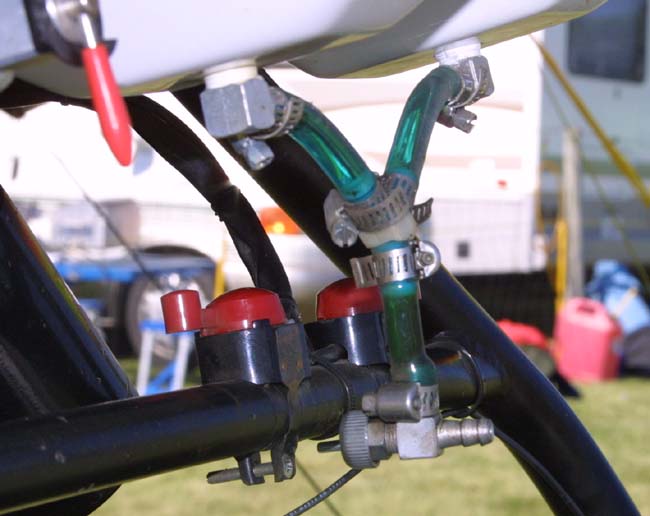|
Aircraft are designed to have this water safely drain
from the aircraft. The current standards are:
FAR 23.971 Fuel tank sump.
(a) Each fuel tank must have a drainable sump with an effective
capacity, in the normal ground and flight attitudes, and
(b) Each fuel tank must allow drainage of any hazardous
quantity of water from any part of the tank to its sump with the
aircraft in the normal ground attitude.
FAR 23.999 Fuel System Drains. There must be at least one drain to
allow safe drainage of the entire fuel system with the aircraft in its
normal ground attitude.
Previous Australia certification standards, such as CAO 101.22 para
3.2(1), included similar requirements. All aircraft certificated for
operation in Australia are therefore required to have suitable water
drain facilities.
Unfortunately, experience during the AVGAS fuel crisis demonstrated
that some aircraft do not have satisfactory water drain facilities.
Also, there is evidence that some fuel tanks provided as spares for
Tiger Moth aircraft do not have suitable water drain facilities.
Finally, Transport Canada FEED-BACK 3/4/2000 noted corrosion problems
they have recorded due to the presence of water in fuel.
Description of Problem
Aircraft may not have suitable water drain facilities. Water drain
samples taken on daily flights may therefore not be representative of
fuel in the aircraft, which could result in corrosion of vital fuel
system components. Tiger Moth Aircraft
When the Tiger Moth aircraft is in flight the sump is the lowest
point, but when the aircraft is on the ground (tail down) the sump is
not the lowest point on the fuel tank. When these aircraft were used
for agricultural operations the aircraft were often left standing in
all weather and a large amount of water frequently resulted in the
tanks. Many operators fitted two extra drains at the lowest point in
the tanks (tail down) to drain excess water that the sump could not
handle.
Spare tanks are delivered with only one drain fitted. Fitment
of the extra drains is not mandatory, and may not be necessary if the
aircraft is regularly sheltered. Operators of Tiger Moth aircraft
should however consider the need to have extra drain points installed.
Recommended Continuing
Maintenance Actions
The fuel system must be inspected at every 100 hour maintenance
action. Should this inspection reveal evidence of water remaining in
the fuel system, maintenance staff should test the fuel system for
continuing compliance with the basis of certification, as described
above.
One way to test the water drain facilities is to add a small
measured amount of water into a fuel tank while the aircraft is on a
level surface and the aircraft is in the normal ground attitude. The
same amount of water should then move to the tank sump, and be drained
from the aircraft. Any unexpected missing amount of water is evidence
that the fuel system does not meet the drain criteria.
FAA AC 20-125, Water In Aviation Fuels, para 7 c suggests that it
may be necessary to gently rock the wings of some aircraft while
draining the sump in order to completely drain all the water.
The water added must be clean; normal drinking water is adequate.
The amount of water added should be appropriate to the tank size, and
not exceed the minimum sump capacity, 400 ml. The water should be
added while the tank is free of fuel.
Care must be taken, subsequent to this test, to ensure that the
fuel tank is thoroughly dried prior to being refuelled and entering
service.
Corrective Action
Correction of the problem may entail smoothing the surface of bag
tanks, or ensuring the aircraft fuel system conforms to the
manufacturer's requirements, or installation of a modification to
incorporate improved drain points. A number of aircraft have SBs
available to install extra drain points. Should the aircraft
manufacturer not have a suitable SB available, it may be necessary to
develop an approved modification for the aircraft.
If the test demonstrated that gentle rocking of the wings was
necessary to move all water in the fuel tank to the drains, the
aircraft owner/operator should be informed of procedures necessary to
completely drain the fuel tanks of residual water. It may also be
necessary to confirm that the pilot/operator is aware of requirements
in CAO 20.2, Air Service Operations Safety Precautions Before Flight,
to conduct regular tests for the presence of water in the fuel. |


